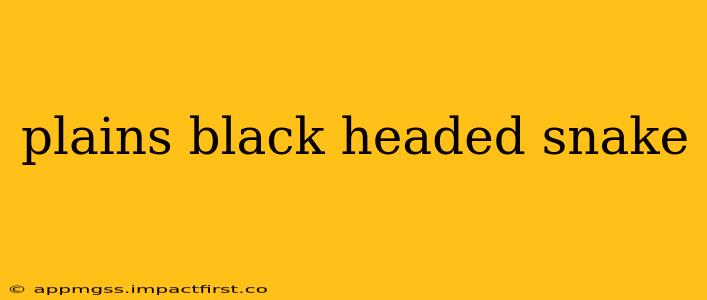The Plains Black-headed Snake (Tantilla nigriceps) is a fascinating and often overlooked reptile inhabiting the grasslands and prairies of North America. While its name suggests a uniformly dark head, its appearance is more nuanced, and its behavior presents a unique blend of shy demeanor and effective survival strategies. This guide delves into the specifics of this intriguing snake, addressing common questions and providing insights into its ecology and conservation.
What does a Plains Black-headed Snake look like?
The Plains Black-headed Snake is a relatively small snake, typically reaching lengths of 10-18 inches. As its name implies, its head is usually darker than its body, often appearing black or dark brown. However, this coloration can vary, and some individuals might exhibit a more brownish or gray head. The body is typically a light brown, tan, or grayish color, often with subtle darker markings along its back. These markings aren't always distinct and can be difficult to discern. The scales are smooth, giving it a sleek appearance. It's important to distinguish it from potentially venomous snakes in its range, which often have keeled scales (scales with ridges).
Where do Plains Black-headed Snakes live?
The Plains Black-headed Snake's range is primarily concentrated in the central Great Plains of North America, spanning parts of the United States and potentially extending into northern Mexico. They prefer grasslands, prairies, and other open habitats with loose soil for burrowing. They are often found near streams or other sources of water. Their habitat preference reflects their burrowing lifestyle and their diet, which consists largely of insects found in these environments.
What do Plains Black-headed Snakes eat?
These snakes are primarily insectivores, feeding largely on ants, beetles, and other insects they find underground or on the surface. Their diet is an important factor in their ecological role, as they help control insect populations within their habitat. Their small size and slender build are well-suited to hunting small prey within burrows and beneath ground cover.
Are Plains Black-headed Snakes venomous?
No, Plains Black-headed Snakes are not venomous. They are completely harmless to humans. Their small size and docile nature mean they pose no threat, even if accidentally handled. Their primary defense mechanism is to flee and hide in their burrows when threatened.
How do Plains Black-headed Snakes reproduce?
The Plains Black-headed Snake is oviparous, meaning it lays eggs. The female typically lays a clutch of 2-6 eggs, which are deposited in suitable underground locations, often within the soil or under rocks, providing protection from predators and environmental fluctuations. The young snakes emerge several weeks later, already independent and capable of foraging for their own food.
What are the conservation status and threats to Plains Black-headed Snakes?
While not currently listed as threatened or endangered, the Plains Black-headed Snake, like many other grassland species, faces potential threats from habitat loss and degradation. Conversion of grasslands to agricultural lands or urban development reduces suitable habitat and fragments populations. Pesticide use can also affect their food sources and potentially harm the snakes directly. Continued monitoring and conservation efforts to protect grassland ecosystems are important to ensure the long-term survival of this species.
Are Plains Black-headed Snakes common?
The relative abundance of Plains Black-headed Snakes can vary depending on location and specific habitat conditions. In areas with suitable habitat and minimal disturbance, they can be relatively common, though they often remain elusive due to their secretive nature. Their shy behavior and cryptic coloration contribute to their often-unnoticed presence within their ecosystems.
This comprehensive guide offers a detailed look into the life of the Plains Black-headed Snake. Further research into specific regional populations and ongoing conservation initiatives would enhance our understanding and ensure the protection of this fascinating reptile and its fragile grassland habitats.
